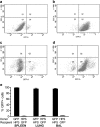The alveolar epithelium determines susceptibility to lung fibrosis in Hermansky-Pudlak syndrome
- PMID: 23043085
- PMCID: PMC3530211
- DOI: 10.1164/rccm.201207-1206OC
The alveolar epithelium determines susceptibility to lung fibrosis in Hermansky-Pudlak syndrome
Abstract
Rationale: Hermansky-Pudlak syndrome (HPS) is a family of recessive disorders of intracellular trafficking defects that are associated with highly penetrant pulmonary fibrosis. Naturally occurring HPS mice reliably model important features of the human disease, including constitutive alveolar macrophage activation and susceptibility to profibrotic stimuli.
Objectives: To decipher which cell lineage(s) in the alveolar compartment is the predominant driver of fibrotic susceptibility in HPS.
Methods: We used five different HPS and Chediak-Higashi mouse models to evaluate genotype-specific fibrotic susceptibility. To determine whether intrinsic defects in HPS alveolar macrophages cause fibrotic susceptibility, we generated bone marrow chimeras in HPS and wild-type mice. To directly test the contribution of the pulmonary epithelium, we developed a transgenic model with epithelial-specific correction of the HPS2 defect in an HPS mouse model.
Measurements and main results: Bone marrow transplantation experiments demonstrated that both constitutive alveolar macrophage activation and increased susceptibility to bleomycin-induced fibrosis were conferred by the genotype of the lung epithelium, rather than that of the bone marrow-derived, cellular compartment. Furthermore, transgenic epithelial-specific correction of the HPS defect significantly attenuated bleomycin-induced alveolar epithelial apoptosis, fibrotic susceptibility, and macrophage activation. Type II cell apoptosis was genotype specific, caspase dependent, and correlated with the degree of fibrotic susceptibility.
Conclusions: We conclude that pulmonary fibrosis in naturally occurring HPS mice is driven by intracellular trafficking defects that lower the threshold for pulmonary epithelial apoptosis. Our findings demonstrate a pivotal role for the alveolar epithelium in the maintenance of alveolar homeostasis and regulation of alveolar macrophage activation.
Figures






Comment in
-
Hermansky-Pudlak syndrome interstitial pneumonia: it's the epithelium, stupid!Am J Respir Crit Care Med. 2012 Nov 15;186(10):939-40. doi: 10.1164/rccm.201210-1771ED. Am J Respir Crit Care Med. 2012. PMID: 23155210 Free PMC article. No abstract available.
References
-
- King TE, Jr, Pardo A, Selman M. Idiopathic pulmonary fibrosis. Lancet 2011;378:1949–1961 - PubMed
-
- Gahl WA, Brantly M, Kaiser-Kupfer MI, Iwata F, Hazelwood S, Shotelersuk V, Duffy LF, Kuehl EM, Troendle J, Bernardini I. Genetic defects and clinical characteristics of patients with a form of oculocutaneous albinism (Hermansky-Pudlak syndrome). N Engl J Med 1998;338:1258–1264 - PubMed
-
- Brantly M, Avila NA, Shotelersuk V, Lucero C, Huizing M, Gahl WA. Pulmonary function and high-resolution CT findings in patients with an inherited form of pulmonary fibrosis, Hermansky-Pudlak syndrome, due to mutations in HPS-1. Chest 2000;117:129–136 - PubMed
Publication types
MeSH terms
Substances
Grants and funding
LinkOut - more resources
Full Text Sources
Other Literature Sources
Medical
Molecular Biology Databases

